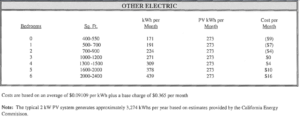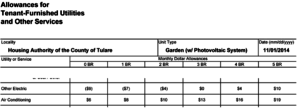The Housing Authority of the County of Tulare (HACT) has developed a promising model for enabling owners of low-income affordable rental housing to finance the cost of installing solar PV systems on tenant meters. In this blog, I describe how other housing authorities can and should emulate Tulare’s innovative and yet relatively simple approach, which has the power to overcome the split incentive challenge and unduly complex administrative barriers that typically plague owners of low-income rental housing.
Over the last 10 years a number of techniques and methods have been advanced to address deficiencies in the methodologies established under federal policy for setting utility allowances. The rationale for these actions is simple: we need reforms to utility allowance practices and policies to remove split incentive barriers that stymie energy investments.
HACT has developed a promising model without the hoopla and hype that has accompanied other approaches. Indeed, I came on this approach just as I had nearly reached the conclusion that we had hit a dead end in finding a coherent and cost-effective pathway for advancing renewable energy retrofits benefiting low-income rental units without large public subsidies. The locally grown innovation in Visalia is simple, cost-effective, and worth our serious attention and consideration.
What is going on in Tulare?
 For a number of years, Tulare County has been a renewable energy leader in the San Joaquin Valley through an integrated effort to encourage the implementation of energy efficiency and clean energy technologies. The county has a model solar permitting process and has facilitated the development of solar farms and workforce development initiatives to spur economic growth.
For a number of years, Tulare County has been a renewable energy leader in the San Joaquin Valley through an integrated effort to encourage the implementation of energy efficiency and clean energy technologies. The county has a model solar permitting process and has facilitated the development of solar farms and workforce development initiatives to spur economic growth.
Rising electricity costs has been an impetus for these efforts. New utility rates adopted by the California Public Utilities Commission include an overall 7.7% increase in electricity rates and mandatory time-of-use (TOU) rates. The increase in electricity rates and changing tariff structure provide opportunities for scaling solar installations throughout the county.
In this hotbed of activities to lower electric costs and curb greenhouse gas emissions, the Housing Authority too is leading efforts to facilitate solar investments in affordable housing. Because of the increasing growth of solar in Tulare County and throughout California, HACT has developed a utility allowance schedule for affordable rental units that are equipped with a Photovoltaic (PV) system. Since the use of Public Housing Authority (PHA) schedules extends to properties financed with Low Income Housing Tax Credits (LIHTC), tax credit properties can also use this schedule if the property has a qualifying solar system serving residents.
What is a Solar Utility Allowance?
HACT’s solar utility allowance is based on an estimate of energy consumption and applicable fuel types and utility rates for the utility and service categories specified on HUD Utility Allowance Form 52667 (Heating, Cooking, Other Electric, Air Conditioning, Water Heating, etc.) for a variety of building and unit types. All public housing authorities in California use a similar approach. What is added to the schedule for Tulare County is a calculated offset for renewable energy measures, which is applied only if the property has a qualifying system.
Under federal regulation, “the utility allowance schedule must be determined based on the typical cost of utilities and services paid by energy-conservative households that occupy housing of similar size and type in the same locality. In developing the schedule, the PHA must use normal patterns of consumption for the community as a whole and current utility rates.”[i]
To comply with federal requirements, HACT uses standard engineering heat loss/gain calculation methods and the standard consumption levels for various systems and equipment to estimate tenant utility consumption baselines for each building type and unit size. To determine the amount of the utility allowance by building /unit type, applicable utility rates and fees are applied to the estimated consumption level. The solar offset is calculated through a separate process, described below, and factored into the utility allowance calculation if the property has a qualifying solar system.
How were the solar offsets calculated?
The methodology HACT used to determine the offset and utility allowance for properties with solar PV systems is described in a paper prepared by National Facilities Consultants.[ii] This methodology assumes a solar PV system scaled to provide 2kW for each residential unit at the multifamily rental property. HACT’s analysis determined that a typical 2 kW solar PV system in Tulare County would generate 273 kWh per unit per month, or 3,276 kWh per unit per year.
As shown in the table below, an equal amount of solar PV generation is allocated for each unit type regardless of unit size. While this approach does not consider consumption difference based on unit size, it is a simple and a straightforward method for allocating power to tenants. Each household gets an equal share of the power generated at the site, which averages at least 273 kWh per month over a 12-month period. This consumption is offset from the estimated consumption for each building/unit type.
The value of the PV generation is set at a utility rate of $0.091 per kWh. This rate reflects California Alternative Rate for Energy tariff schedules set by Southern California Edison and Pacific Gas and Electric. Using this rate structure and the estimated value of solar production allocated, as an offset, is $25 per unit per month.
Application of Solar Utility Allowance
This relatively simple approach has potentially wide application to public housing authorities throughout California.
The first step is for the PHA to develop a utility allowance schedule pursuant to HUD regulations. The PHA can follow its current policies and practices and use the current utility allowance schedules, or the PHA may wish to do a more detailed analysis of consumption by building/unit type to more precisely estimate electric demands. Either approach is permissible, but the consumption-based analysis is generally a more reliable method for determining tenant energy requirements and is more transparent.
Next, the PHA would determine the basis for setting the solar PV generation offset.
In HACT’s case, they set a 2kW per unit requirement as the basis for the solar offset. This benchmark can of course vary based on geography and other consideration. The benefit of this approach is that it is simple and a relatively easy means for setting a minimum offset level. Once the a minimum unit system size is set, the kWh production for the solar array meeting the benchmark can be estimated using the California Energy Commission CECPC Calculator, or other solar calculators used by the solar industry.
Alternatively, a PHA could set solar offsets based on a specified percentage reduction to tenant electricity consumption or costs. For example, if the PHA’s goal is to reduce electricity consumption or costs by 50%, and the current utility allowance for electricity is $40 per month, the solar system must be sized to generate a sufficient level of kWh to equal $240 per year ($20 a month). If tenant electricity rates are $0.12/kWh, this means that the PV system must be sized to produce at least 2,000 kWh per unit annually. The appropriate PV system size can then be determined from this performance metric.
The final step is determining the utility allowance offset. After the PHA determines the per unit annual kWh production required by the solar system, the amount of the monthly offset can be determined by multiplying the annual PV production level set by the applicable tariff and then dividing by 12.
HACT includes the full PV offset in its utility allowance schedule in the “Other Electric” category. Accordingly, the allowance shown for this category is negative for some unit sizes. This approach is simple and straightforward and avoids the complexities of calculating and sub-allocating solar PV generation offsets across multiple categories.
Implementation
To implement this approach, the PHA must determine that the property has a PV system meeting the requirements set by the PHA. That may this determination two questions must be answered.
- Does the PV system meet the kW/units or kWh/unit requirements set by the PHA?
- Is the power generated by the PV system allocated on the tenant’s on their utility bill?
California has a well-established process for allocating solar production to low-income rental units through Virtual Net Metering (VNM) rules adopted by the California Public Utilities Commission. Using VNM, the property owner designates a portion of the PV system’s production to tenant units and a portion to common areas. The percentage distribution between common areas and electric loads will depend on respective electric loads, the size of the PV system, and rules set for any solar incentive program that may apply. The result of this process is that each utility meter at the property will receive a fixed percentage of the solar production at the site each day. This production allocated to each unit appears on the tenant’s utility bill as a direct solar credit. The value of the solar production depends on the utility rate in use at the utility meter and the time when the solar generation was added to the grid. The tenant’s utility bill is reduced by the value of each kWh produced and allocated to the tenant unit.
Documentation for establishing that a system qualifies for the UA with solar could include documentation verifying PV system size, PV system out (annual and monthly, VNM allocations to tenant units and/or sub-allocations for each unit type, and annual verification of site PV production from the solar meter(s) installed at the site.
Why is a PHA solar utility allowance useful to affordable multifamily housing?
Rent-restricted multifamily affordable rental properties may need to recover a portion of the energy savings received by the tenants to cover the costs of extending the PV system to tenant meters. This is generally the case if the property does not have access to cash flows, reserves, or solar incentives programs.
Property owners generally believe that the most direct means to capture a portion of tenant savings through adjustments to tenant utility allowances. However, there are many policy impediments that make this process complicated, costly, and in many cases impractical.
The Solar Utility Allowance developed for Tulare County is an important pathway and an effective solution to removing these policy barriers and promoting solar installations.
Currently, most LIHTC-financed properties typically use PHA utility allowance schedules.
My own view is that by offering a PHA utility allowance that includes an option for offsetting electricity consumption by the amount of PV production credits received by tenants, PHAs can provide LIHTC property owners with a simple and easily implementable solution for resolving split incentives barriers and providing low-income renters with greater access to clean energy technology.
I encourage PHAs to follow HACT’s leadership and innovation.
[i] Part 982.517. Utility Allowance Schedule. See: https://www.law.cornell.edu/cfr/text/24/982.517.
[ii] Utility Allowance Update, Section 8 Photovoltaic, Tulare County Housing Authority. July 2014.

